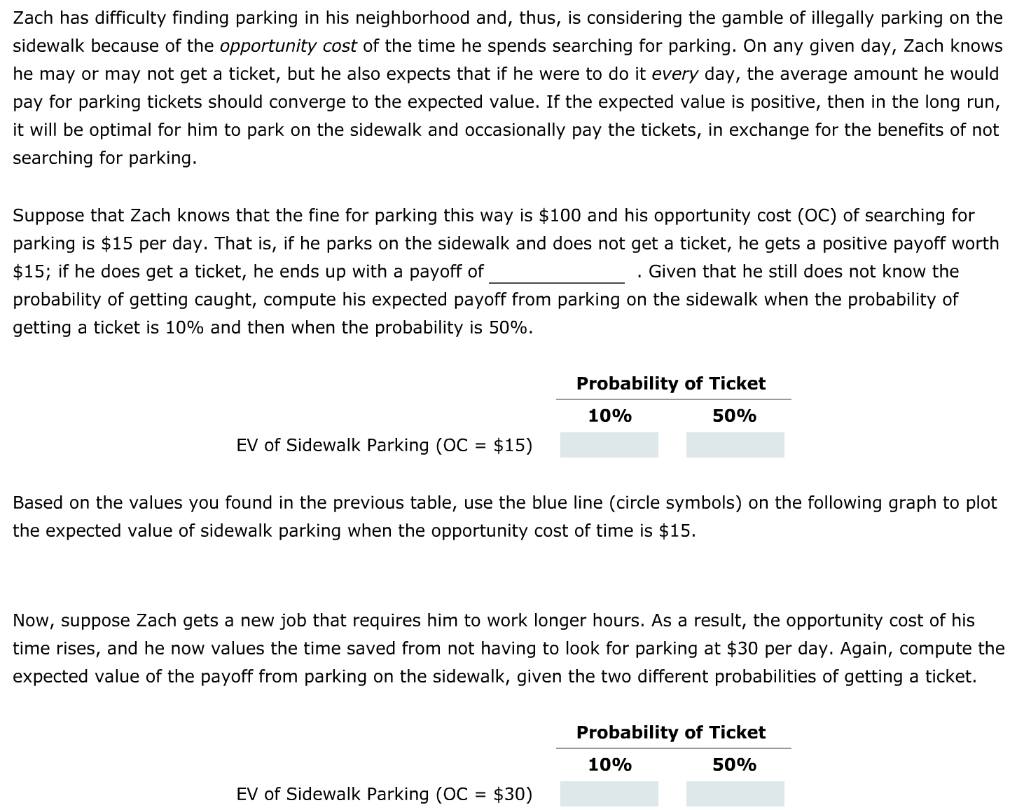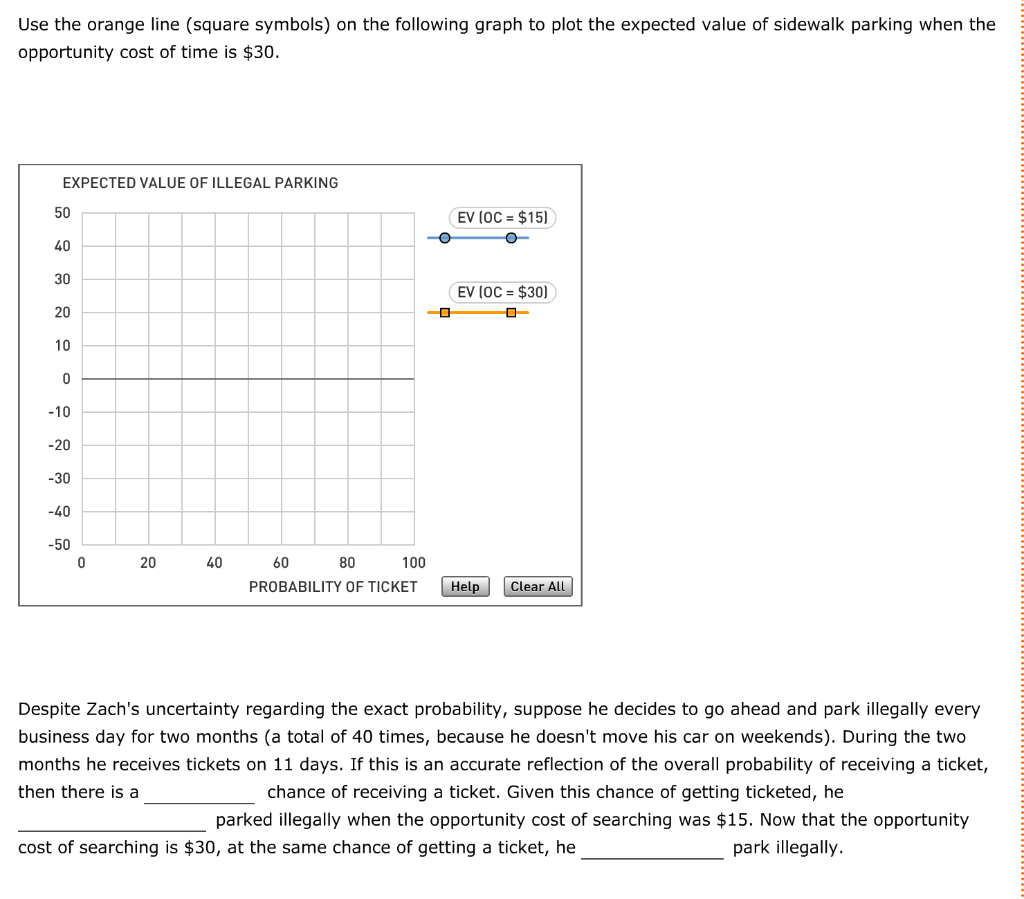

Zach has difficulty finding parking in his neighborhood and, thus, is considering the gamble of illegally parking on the sidewalk because of the opportunity cost of the time he spends searching for parking. On any given day, Zach knows he may or may not get a ticket, but he also expects that if he were to do it every day, the average amount he would pay for parking tickets should converge to the expected value. If the expected value is positive, then in the long run, it will be optimal for him to park on the sidewalk and occasionally pay the tickets, in exchange for the benefits of not searching for parking. Suppose that Zach knows that the fine for parking this way is $100 and his opportunity cost (OC) of searching for parking is $15 per day. That is, if he parks on the sidewalk and does not get a ticket, he gets a positive payoff worth $15; if he does get a ticket, he ends up with a payoff of . Given that he still does not know the probability of getting caught, compute his expected payoff from parking on the sidewalk when the probability of getting a ticket is 10% and then when the probability is 50%. Probability of Ticket 10% 50% EV of Sidewalk Parking (OC = $15) Based on the values you found in the previous table, use the blue line (circle symbols) on the following graph to plot the expected value of sidewalk parking when the opportunity cost of time is $15. Now, suppose Zach gets a new job that requires him to work longer hours. As a result, the opportunity cost of his time rises, and he now values the time saved from not having to look for parking at $30 per day. Again, compute the expected value of the payoff from parking on the sidewalk, given the two different probabilities of getting a ticket. Probability of Ticket 10% 50% EV of Sidewalk Parking (OC = $30) Use the orange line (square symbols) on the following graph to plot the expected value of sidewalk parking when the opportunity cost of time is $30. EXPECTED VALUE OF ILLEGAL PARKING 50 EV (OC = $15) O 40 30 EV (OC = $30) 20 10 0 -10 -20 -30 -40 -50 0 20 40 60 80 100 PROBABILITY OF TICKET Help Clear All Despite Zach's uncertainty regarding the exact probability, suppose he decides to go ahead and park illegally every business day for two months (a total of 40 times, because he doesn't move his car on weekends). During the two months he receives tickets on 11 days. If this is an accurate reflection of the overall probability of receiving a ticket, then there is a chance of receiving a ticket. Given this chance of getting ticketed, he parked illegally when the opportunity cost of searching was $15. Now that the opportunity cost of searching is $30, at the same chance of getting a ticket, he park illegally. Zach has difficulty finding parking in his neighborhood and, thus, is considering the gamble of illegally parking on the sidewalk because of the opportunity cost of the time he spends searching for parking. On any given day, Zach knows he may or may not get a ticket, but he also expects that if he were to do it every day, the average amount he would pay for parking tickets should converge to the expected value. If the expected value is positive, then in the long run, it will be optimal for him to park on the sidewalk and occasionally pay the tickets, in exchange for the benefits of not searching for parking. Suppose that Zach knows that the fine for parking this way is $100 and his opportunity cost (OC) of searching for parking is $15 per day. That is, if he parks on the sidewalk and does not get a ticket, he gets a positive payoff worth $15; if he does get a ticket, he ends up with a payoff of . Given that he still does not know the probability of getting caught, compute his expected payoff from parking on the sidewalk when the probability of getting a ticket is 10% and then when the probability is 50%. Probability of Ticket 10% 50% EV of Sidewalk Parking (OC = $15) Based on the values you found in the previous table, use the blue line (circle symbols) on the following graph to plot the expected value of sidewalk parking when the opportunity cost of time is $15. Now, suppose Zach gets a new job that requires him to work longer hours. As a result, the opportunity cost of his time rises, and he now values the time saved from not having to look for parking at $30 per day. Again, compute the expected value of the payoff from parking on the sidewalk, given the two different probabilities of getting a ticket. Probability of Ticket 10% 50% EV of Sidewalk Parking (OC = $30) Use the orange line (square symbols) on the following graph to plot the expected value of sidewalk parking when the opportunity cost of time is $30. EXPECTED VALUE OF ILLEGAL PARKING 50 EV (OC = $15) O 40 30 EV (OC = $30) 20 10 0 -10 -20 -30 -40 -50 0 20 40 60 80 100 PROBABILITY OF TICKET Help Clear All Despite Zach's uncertainty regarding the exact probability, suppose he decides to go ahead and park illegally every business day for two months (a total of 40 times, because he doesn't move his car on weekends). During the two months he receives tickets on 11 days. If this is an accurate reflection of the overall probability of receiving a ticket, then there is a chance of receiving a ticket. Given this chance of getting ticketed, he parked illegally when the opportunity cost of searching was $15. Now that the opportunity cost of searching is $30, at the same chance of getting a ticket, he park illegally








